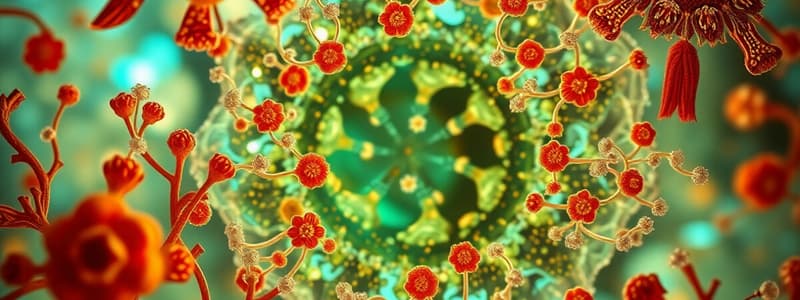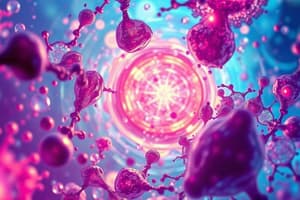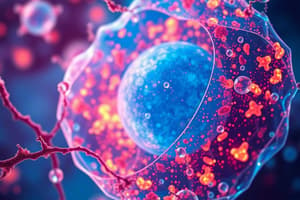Podcast
Questions and Answers
Which of the following is a function of transport proteins?
Which of the following is a function of transport proteins?
- Regulate the movement of substances across the membrane (correct)
- Identify cells as belonging to the body
- Provide structure to the cell membrane
- Bind to ligands and initiate cellular processes
Which of these lipids is located on the outer phospholipid region of the cell membrane?
Which of these lipids is located on the outer phospholipid region of the cell membrane?
- Phospholipids
- Cholesterol
- Glycolipids (correct)
- All of the above
What is the primary function of cholesterol in the cell membrane?
What is the primary function of cholesterol in the cell membrane?
- To act as a signaling molecule
- To transport nutrients across the cell membrane
- To strengthen and stabilize the membrane (correct)
- To provide energy for cellular processes
Which type of membrane protein is embedded within and extends across the phospholipid bilayer?
Which type of membrane protein is embedded within and extends across the phospholipid bilayer?
Which of these is NOT a function of the plasma membrane?
Which of these is NOT a function of the plasma membrane?
What is the function of cell surface receptors?
What is the function of cell surface receptors?
What is the main function of enzymes in the cell membrane?
What is the main function of enzymes in the cell membrane?
What is the term for the carbohydrate groups attached to integral proteins?
What is the term for the carbohydrate groups attached to integral proteins?
What is the primary function of anchoring sites in the cell membrane?
What is the primary function of anchoring sites in the cell membrane?
Which type of membrane transport requires energy and moves substances against their concentration gradient?
Which type of membrane transport requires energy and moves substances against their concentration gradient?
Which of the following is NOT a characteristic of passive processes of membrane transport?
Which of the following is NOT a characteristic of passive processes of membrane transport?
Which of the following is an example of a molecule that can move through the plasma membrane via simple diffusion?
Which of the following is an example of a molecule that can move through the plasma membrane via simple diffusion?
What is the difference between channel-mediated diffusion and carrier-mediated diffusion?
What is the difference between channel-mediated diffusion and carrier-mediated diffusion?
Which of the following factors would increase the rate of diffusion?
Which of the following factors would increase the rate of diffusion?
What is the role of the plasma membrane in cell communication?
What is the role of the plasma membrane in cell communication?
Which of the following is NOT a characteristic of the plasma membrane?
Which of the following is NOT a characteristic of the plasma membrane?
Which of the following solutions cause the cell to shrink?
Which of the following solutions cause the cell to shrink?
What is the primary function of the Sodium-Potassium pump?
What is the primary function of the Sodium-Potassium pump?
Which of the following is NOT a characteristic of active transport?
Which of the following is NOT a characteristic of active transport?
What type of active transport involves the movement of two substances in the same direction?
What type of active transport involves the movement of two substances in the same direction?
What is the name of the process where erythrocytes rupture due to being placed in a hypotonic solution?
What is the name of the process where erythrocytes rupture due to being placed in a hypotonic solution?
What is the main difference between primary and secondary active transport?
What is the main difference between primary and secondary active transport?
Which of the following best describes the movement of water in a hypotonic solution?
Which of the following best describes the movement of water in a hypotonic solution?
Which of the following is NOT a type of endocytosis?
Which of the following is NOT a type of endocytosis?
What is the primary function of phagocytosis in a cell?
What is the primary function of phagocytosis in a cell?
What is the process called when a cell shrinks due to being placed in a hypertonic solution?
What is the process called when a cell shrinks due to being placed in a hypertonic solution?
Which of the following statements accurately describes exocytosis?
Which of the following statements accurately describes exocytosis?
What is the main purpose of receptor-mediated endocytosis?
What is the main purpose of receptor-mediated endocytosis?
Which of the following statements accurately describes the role of ATP in vesicular transport?
Which of the following statements accurately describes the role of ATP in vesicular transport?
What is the common characteristic shared by exocytosis and endocytosis?
What is the common characteristic shared by exocytosis and endocytosis?
Familial hypercholesteremia is a genetic disorder affecting the process of:
Familial hypercholesteremia is a genetic disorder affecting the process of:
Which of the following is NOT a consequence of familial hypercholesteremia?
Which of the following is NOT a consequence of familial hypercholesteremia?
Which of these microscopes produces a three-dimensional image of a specimen?
Which of these microscopes produces a three-dimensional image of a specimen?
What is the main function of the plasma membrane?
What is the main function of the plasma membrane?
Which of the following is NOT a membrane-bound organelle?
Which of the following is NOT a membrane-bound organelle?
What is the function of the nucleolus?
What is the function of the nucleolus?
What is cytosol?
What is cytosol?
Which of these is NOT a function of cells?
Which of these is NOT a function of cells?
Which of the following is NOT a type of inclusion?
Which of the following is NOT a type of inclusion?
What is the main difference between a TEM and a SEM?
What is the main difference between a TEM and a SEM?
What is the primary driving force behind the movement of water across a semipermeable membrane during osmosis?
What is the primary driving force behind the movement of water across a semipermeable membrane during osmosis?
Which of the following is a characteristic of nonpermeable solutes?
Which of the following is a characteristic of nonpermeable solutes?
What is the term used to describe the ability of a solution to change the volume or pressure of a cell by osmosis?
What is the term used to describe the ability of a solution to change the volume or pressure of a cell by osmosis?
Which type of solution has the same relative concentration of solutes as the cytosol of a cell?
Which type of solution has the same relative concentration of solutes as the cytosol of a cell?
How do aquaporins facilitate the movement of water across the cell membrane?
How do aquaporins facilitate the movement of water across the cell membrane?
What happens to the osmotic pressure when the concentration gradient between two solutions increases?
What happens to the osmotic pressure when the concentration gradient between two solutions increases?
What is the primary difference between osmosis and diffusion?
What is the primary difference between osmosis and diffusion?
Which of the following is NOT a characteristic of facilitated diffusion?
Which of the following is NOT a characteristic of facilitated diffusion?
Flashcards
Cytology
Cytology
The study of cells and their structures.
Light Microscope (LM)
Light Microscope (LM)
Microscope that produces a two-dimensional image using light.
Electron Microscope (EM)
Electron Microscope (EM)
Microscope that uses electron beams for higher magnification and resolution.
Plasma Membrane
Plasma Membrane
Signup and view all the flashcards
Nucleus
Nucleus
Signup and view all the flashcards
Organelles
Organelles
Signup and view all the flashcards
Membrane-bound Organelles
Membrane-bound Organelles
Signup and view all the flashcards
Inclusions
Inclusions
Signup and view all the flashcards
Enzymes
Enzymes
Signup and view all the flashcards
Anchoring sites
Anchoring sites
Signup and view all the flashcards
Cell-adhesion proteins
Cell-adhesion proteins
Signup and view all the flashcards
Passive transport
Passive transport
Signup and view all the flashcards
Active transport
Active transport
Signup and view all the flashcards
Diffusion
Diffusion
Signup and view all the flashcards
Facilitated diffusion
Facilitated diffusion
Signup and view all the flashcards
Channel-mediated diffusion
Channel-mediated diffusion
Signup and view all the flashcards
Phospholipids
Phospholipids
Signup and view all the flashcards
Cholesterol
Cholesterol
Signup and view all the flashcards
Glycolipids
Glycolipids
Signup and view all the flashcards
Integral proteins
Integral proteins
Signup and view all the flashcards
Peripheral proteins
Peripheral proteins
Signup and view all the flashcards
Transport proteins
Transport proteins
Signup and view all the flashcards
Cell surface receptors
Cell surface receptors
Signup and view all the flashcards
Hypotonic solution
Hypotonic solution
Signup and view all the flashcards
Lysis
Lysis
Signup and view all the flashcards
Hypertonic solution
Hypertonic solution
Signup and view all the flashcards
Crenation
Crenation
Signup and view all the flashcards
Sodium-potassium pump
Sodium-potassium pump
Signup and view all the flashcards
Primary active transport
Primary active transport
Signup and view all the flashcards
Symport vs Antiport
Symport vs Antiport
Signup and view all the flashcards
Vesicular transport
Vesicular transport
Signup and view all the flashcards
Exocytosis
Exocytosis
Signup and view all the flashcards
Endocytosis
Endocytosis
Signup and view all the flashcards
Phagocytosis
Phagocytosis
Signup and view all the flashcards
Pinocytosis
Pinocytosis
Signup and view all the flashcards
Receptor-mediated endocytosis
Receptor-mediated endocytosis
Signup and view all the flashcards
ATP in vesicular transport
ATP in vesicular transport
Signup and view all the flashcards
Familial Hypercholesterolemia
Familial Hypercholesterolemia
Signup and view all the flashcards
Carrier Protein Function
Carrier Protein Function
Signup and view all the flashcards
Osmosis
Osmosis
Signup and view all the flashcards
Permeable Solutes
Permeable Solutes
Signup and view all the flashcards
Nonpermeable Solutes
Nonpermeable Solutes
Signup and view all the flashcards
Osmotic Pressure
Osmotic Pressure
Signup and view all the flashcards
Hydrostatic Pressure
Hydrostatic Pressure
Signup and view all the flashcards
Tonicity
Tonicity
Signup and view all the flashcards
Isotonic Solution
Isotonic Solution
Signup and view all the flashcards
Study Notes
Microscopy
- Microscopes are necessary for viewing small-scale structures
- Staining techniques enhance contrast in images
- Light microscopes (LM) produce two-dimensional images by passing light through a specimen
- Electron microscopes (EM) offer greater magnification and resolution than light microscopes.
- Transmission electron microscopes (TEM) produce 2-D images by directing an electron beam through thin-cut sections of a specimen.
- Scanning electron microscopes (SEM) create 3-D images by directing an electron beam across the surface of a specimen.
Cell Size and Shape
- Cells exhibit various sizes and shapes
- Common shapes include spherical, cube-like, column-like, cylindrical, disc-shaped, and irregular.
Common Cell Features
- Plasma membrane: Forms a boundary between the cell's interior and external environment. Modified extensions include cilia, flagella, and microvilli.
- Nucleus: Largest cell structure, enclosed by a nuclear envelope. Contains DNA and a nucleolus. Nucleoplasm is the inner fluid.
- Cytoplasm: Cellular contents between the plasma membrane and the nucleus. Includes cytosol, organelles, and inclusions.
- Cytosol (intracellular fluid): Viscous fluid with high water content and dissolved macromolecules/ions
- Organelles: Organized structures with varied functions
- Inclusions: Cytosol stores temporarily. Not considered organelles (e.g., pigments, glycogen, triglycerides).
Lipid Components of the Cell
- Plasma membranes are a fluid mixture of equal parts lipid and protein by weight.
- They regulate the movement of most substances into and out of the cell.
- Phospholipids are the primary lipid component.
- Cholesterol and glycolipids are other types of lipids found in membranes.
- Phospholipids feature a polar head and two nonpolar tails, creating a bilayer structure.
Membrane Proteins
- Proteins make up half the mass of the plasma membrane.
- They perform most of the membrane's functions.
- Integral proteins are embedded within the phospholipid bilayer.
- Peripheral proteins are loosely attached to the membrane surface.
Membrane Transport
- Membrane transport is the process substances enter or leave the cell.
- Two categories: passive and active
- Passive Processes: Substances move down their concentration gradient without energy input. (Diffusion and Osmosis) Active processes require energy. (Active transport, vesicular transport)
Passive Transport
- Diffusion: Net movement of molecules or ions from high to low concentration.
- Simple diffusion: Molecules move directly between phospholipid molecules.
- Facilitated diffusion: Proteins aid passage of charged or polar substances.
- Osmosis: Passive movement of water across a semipermeable membrane.
Active Transport
- Primary Active Transport: Directly uses ATP to move a substance against its concentration gradient
- Secondary Active Transport: Uses the energy from one substance moving down its concentration gradient to move a second substance against its concentration gradient.
Vesicular Transport
- Exocytosis: Vesicles fuse with the plasma membrane to release substances out of the cell.
- Endocytosis: Vesicles form from the plasma membrane to bring substances into the cell. Types include phagocytosis, pinocytosis, and receptor-mediated endocytosis.
Cellular Structures
- Endoplasmic Reticulum (ER): Extensive network of membranes. Rough ER has ribosomes and synthesizes proteins, smooth ER is involved in lipid synthesis, and detoxification.
- Golgi Apparatus: Modifies, packages, and sorts proteins.
- Lysosomes: Contain digestive enzymes to break down unwanted materials.
- Peroxisomes: Smaller than lysosomes. Contain enzymes for specific metabolic functions.
- Mitochondria: "Powerhouses" of the cell, involved in cellular respiration.
- Ribosomes: Synthesize proteins.
- Centrosome: Involved in cell division and organization of microtubules.
- Proteasomes: Degrade cellular proteins.
Cell Structures and Functions
- Cytoskeleton: Provides intracellular support and allows movement.
- Microtubules, Microfilaments, Intermediate Filaments: Components of the cytoskeleton.
- Cilia (and Flagella): Hair-like projections that move substances.
- Microvilli: Increase surface area for absorption of materials.
- Membrane Junctions: Tight junctions, desmosomes, gap junctions join cells.
Studying That Suits You
Use AI to generate personalized quizzes and flashcards to suit your learning preferences.



